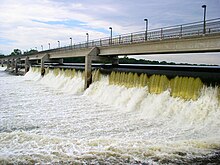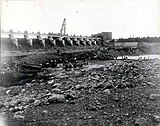Coon Rapids Dam
| Coon Rapids Dam | |
|---|---|
 Coon Rapids Dam in 2021 | |
| Country | United States |
| Location | Anoka County and Hennepin County, Minnesota |
| Coordinates | 45°8′38″N 93°18′41″W / 45.14389°N 93.31139°W |
| Purpose | Originally power generation; recreational since 1969 |
| Status | Operational |
| Construction began | 1913 |
| Opening date | 1914 |
| Built by | H. M. Byllesby & Company (original dam) |
| Owner(s) | Three Rivers Park District |
| Dam and spillways | |
| Type of dam | Concrete gravity dam |
| Impounds | Mississippi River |
| Height | 19 ft (5.8 m) |
| Length | 1,070 ft (330 m) |
| Reservoir | |
| Surface area | 600 acres |
| Maximum length | 6 mi (9.7 km) |
| Power Station | |
| Operator(s) | Northern States Power Company |
| Commission date | 1914 |
| Decommission date | 1966 |
The Coon Rapids Dam is a concrete gravity dam on the Mississippi River located in Brooklyn Park and Coon Rapids, Minnesota. It is approximately 12 miles (19 km) north of downtown Minneapolis. Between 1914 and 1966, it provided hydroelectric power generation for northern Twin Cities suburbs. Since 1969, it has been used primarily for recreation. As the southernmost dam on the Mississippi that does not have any locks, it is the theoretical northern terminus of the navigable portion of the Mississippi River.[note 1] The dam is owned by Hennepin County's Three Rivers Park District; Anoka County owns and operates a park on its side of the river.
Facility


In 1898, plans began to form to build a hydroelectric power generation dam near Coon Rapids, Minnesota.[1] While originally conceived as a private venture, in 1911 Congress approved federal funding for the dam to make it a joint private-public operation.[1] Land was purchased from John Dunn, after whom the island in the middle of the channel is named. H. M. Byllesby & Company began construction the dam in January 1913 and was completed in March 1914; power generation began in August 1914.[2][3]: 113 Over 42,000 cubic yards of concrete were used in the construction of the dam.[1] It had 28 steel gates which were raised and lowered to allow water to flow under them. One of the original steel gates is available for viewing on the Anoka County side of the dam.[4]
The dam does not contain a lock. In November 1913, after construction started, the St. Anthony Falls Commercial Club lobbied for Congress to add a lock to the dam.[5] However, as the river above the dam was deemed not to be navigable, the power company was not required to build the $150,000 lock.[3]: 115 The lack of a lock makes it the theoretical northernmost navigable point on the Mississippi River; however, since 2015, Upper St. Anthony Falls lock have been sealed to prevent the spread of Asian carp and as such Saint Anthony Falls in Minneapolis are the current practical limit.[6]
By the 1960s, hydroelectric generation on the dam was no longer profitable, and power generation was halted in 1966. The plant was demolished in 1967, and in 1969 Northern States Power Company donated the dam to the Hennepin County Parks District.[7] A walkway was constructed across the dam in 1977,[8] and the park opened in 1978.[9]
In 1994, Anoka County entered a thirty-year lease agreement with Three Rivers Park District for the Anoka County side of the dam.[10] Due to the cost of upkeep, Three Rivers Park District considered selling the dam to the Minnesota Department for Natural Resources in 2010, resulting in a dispute with Anoka County in 2011 which caused Three Rivers Park district to revoke the lease.[11][12] Ultimately, Anoka County purchased the leased land from the park district.[13]
1997 reconstruction

By the 1990s, the dam was facing serious wear and tear, and was rated a "significant hazard" by the Army Corps of Engineers with severe effects predicted if the dam collapsed, including possible deaths.[7] Repairs were recommended within five years. The original concrete pilings were wearing away, foundation soil was eroding, and many of the twenty-eight wooden and metal gates were broken and twisted as a result of ice.[7] From 1995 to 1997, Hennepin County Parks carried out a $6.2 million two-year plan to reconstruct the dam. While the original footings were used, the rest of the dam was entirely rebuilt.[14][9] The new dam consisted of four gates with inflatable rubber bladders.[15] Tears in the bladders requiring repair occurred in 1997[16] and 2000,[15] resulting in a complete replacement of the bladders with an upgraded design in 2002.[9]
Later renovation
The rubber bladders installed in the 1997 reconstruction proved to be ineffective in preventing the spread of Asian carp further up the river. Between 2013 and 2014, the rubber bladders were replaced by nine steel gates in a $16 million project.[17] As part of the same renovation, a 450-foot stilling basin was installed, replacing a deteriorating concrete apron.[18][19]
There have been proposals to restore power generation at the dam.[20] Proposals by the park district from 2009 proposed a $30 million plant which would generate 44 megawatts per year.[21] The proposals have not gained traction.[20]
Specifications
The dam consists of a main 1,000-foot (300 m) section with a 103-foot (31 m) control gate and nine additional steel gates, connecting the Hennepin County side to Dunn Island on the Anoka County side of the river. A shorter 400 foot section, originally containing the 200 foot long powerhouse, connects the island to the Anoka County side.[2] The difference between the headwater and tailwater is usually around 19 feet (5.8 m), with a 13-foot difference between the dam and the original riverbed.[2] The pool is around 600 acres, with the effects of the dam diminishing after the Ferry Street bridge in Champlin, about six miles upstream.[3]: 95
Recreation

Three Rivers Park District, a special park district serving the Twin Cities Hennepin, Carver, Dakota, Scott, and Ramsey counties, owns the dam and operates the 160-acre Mississippi Gateway Regional Park on the southwest side of the dam.[22][7][23] Anoka County Parks owns and operates a 446-acre park, Coon Rapids Dam Regional Park, on the northeast of the dam. Many species, including mink, beaver, hawks, osprey, deer, turtles and river otters, can be spotted in the parks.[24] Both parks are sites for the National Parks Passport Program.[25]
Cenaiko Lake, a 281⁄2 acre artificial lake on the Anoka County side, is stocked with Rainbow Trout; other species are present as well.[26][27] Cenaiko Lake was created in 1987 and is named after former Anoka County commissioner Nick Cenaiko.[28][29]

Over 350,000 people visit the parks each year.[30] The dam connects to Elm Creek Park Reserve via the Rush Creek Regional Trail.[31]
Gallery
- Construction of the cofferdam at Coon Rapids Dam.
- Castings for the number three generator unit before unloading from car at Coon Rapids Dam power plant.
- General view looking north showing apron extension at Coon Rapids Dam.
- The number one generator unit inside the powerhouse.
- The dam in 1920, from the Hennepin county side.
- The completed Coon Rapids dam in 1920 with the original "flow under" design present
Notes
References
- ^ a b c Cooper, Philip. "Coon Rapids Hydroelectric Dam | MNopedia". MNopedia. Minnesota Historical Society.
- ^ a b c "Coon Rapids Dam | Coon Rapids, MN - Official Website". www.coonrapidsmn.gov. City of Coon Rapids. Retrieved June 25, 2024.
- ^ a b c Anfinson, John (2003). River of History: A Historic Resources Study of the Mississippi National River and Recreation Area (PDF). U.S. Army Corps of Engineers. Retrieved June 25, 2024.
- ^ "How the Dam Works Historical Marker". www.hmdb.org.
- ^ "Lock Petition Presented". Minneapolis Morning Tribune. November 15, 1913. Retrieved June 25, 2024.
- ^ "H.R.3080 – Water Resources Reform and Development Act of 2014". congress.gov. June 10, 2014. Retrieved June 9, 2015.
- ^ a b c d Trontz, Ian (August 27, 1992). "Coon Rapids dam poses dilemma". Star Tribune. Retrieved June 25, 2024.
- ^ Randels Gillund, Leslie (March 17, 2023). "Coon Rapids — A Fine City by a Dam Site". Anoka County Historical Society. Archived from the original on June 25, 2024. Retrieved June 25, 2024.
- ^ a b c Writer, NS Energy Staff (January 1, 2002). "Coon Rapids gate replacement complete". NS Energy.
- ^ Three Rivers Park District (February 28, 2011). "Coon Rapids Regional Dam Commission Report.pdf". Retrieved June 25, 2024.
- ^ Blake, Laurie; Tribune, Star (July 23, 2011). "Coon Rapids dam's future is secure, but parkland dispute isn't over". Star Tribune. Archived from the original on June 25, 2024. Retrieved June 25, 2024.
- ^ Blake, Laurie; Tribune, Star (April 30, 2011). "Coon Rapids dam has Three Rivers, Anoka County carping over park lease". Star Tribune. Archived from the original on June 25, 2024.
- ^ "Mississippi Gateway Regional Park Master Plan Development | Three Rivers Park District". www.threeriversparks.org. Archived from the original on June 26, 2024. Retrieved June 25, 2024.
- ^ Brunswick, Mark (March 3, 1995). "Dam project raises protest". Star Tribune. pp. 1B, 4B. Retrieved June 25, 2024.
- ^ a b Brunswick, Mark (August 11, 2000). "Tear in gate at Coon Rapids dam may lower water levels". Star Tribune. Retrieved June 25, 2024.
- ^ Brunswick, Mark (October 14, 1997). "Repairs planned for Coon Rapids Dam". Star Tribune. Retrieved June 25, 2024.
- ^ Adams, Jim (April 30, 2014). "Crews to resume work on Coon Rapids Dam". Star Tribune. pp. AA1, AA6. Archived from the original on June 15, 2021.
- ^ Adams, Jim (October 22, 2013). "New gates installed at Coon Rapids Dam to stop Asian carp". Star Tribune. Archived from the original on June 25, 2024.
- ^ "Crews install 2nd of nine Asian carp barriers". Winona Daily News. AP. October 23, 2013. Retrieved November 3, 2024.
- ^ a b DeBow, Matt (July 16, 2022). "Lawmakers discuss hydroelectricity at Coon Rapids Dam". ABC Newspapers. Archived from the original on June 25, 2024. Retrieved June 25, 2024.
- ^ Adams, Jim (October 7, 2009). "Park district wants help for hydroelectric plant in Coon Rapids". Star Tribune. Archived from the original on June 28, 2018. Retrieved June 25, 2024.
- ^ "Mississippi Gateway Regional Park | Three Rivers Park District". Three Rivers Park District. Archived from the original on August 20, 2024.
- ^ Brunswick, Mark (December 20, 2001). "Hennepin Parks now Three Rivers Park District". Star Tribune. Retrieved November 3, 2024.
- ^ "Coon Rapids Dam Regional Park". Anoka County Parks. Archived from the original on July 4, 2024.
- ^ "Passport To Your National Parks Cancellation Station Locations" (PDF). America's National Parks. Retrieved November 3, 2024.
- ^ "Unnamed (02065400) | LakeFinder". Minnesota Department of Natural Resources.
- ^ "Cenaiko Lake". Minnesota Department of Natural Resources. Archived from the original on June 25, 2024. Retrieved June 25, 2024.
- ^ "Nick Cenaiko Sr., former Anoka County commissioner and trade show creator, dies at 79". Twin Cities. December 14, 2011. Archived from the original on June 25, 2024.
- ^ Schranck, Bob (August 6, 1989). "Trout waters run deep and clear". Newspapers.com. Star Tribune. Retrieved June 25, 2024.
- ^ Prather, Shannon (November 17, 2015). "Three Rivers looks at renaming its Coon Rapids Dam Regional Park". Star Tribune. Archived from the original on July 22, 2024. Retrieved June 25, 2024.
- ^ "Rush Creek Regional Trail | Three Rivers Park District". Three Rivers Park District. Archived from the original on August 20, 2024. Retrieved June 30, 2024.






